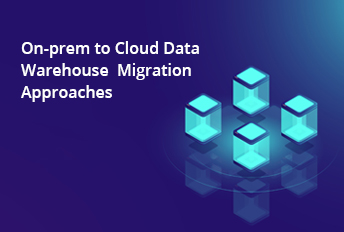
Migrating Data Warehouse to the Cloud: The Ultimate Guide
Migrating your data warehouse to the cloud is crucial.
As organizations begin to realize the need for and importance of data analytics, more and more of them are looking into implementing an enterprise data warehouse to leverage data that would otherwise be trapped in silos. In addition to helping organizations consolidate their data, a data warehouse can be used to maintain data history and make it easier to query data.
While both on-premises and cloud data warehouses offer immense benefits, most organizations today prefer migrating data warehouses to the cloud to go with modern cloud data warehouses, as compared to legacy data warehouses, due to the enhanced agility, scalability, and security they offer.
Cloud-based data warehouses also offer more flexibility and can be less costly for organizations that are just beginning to figure out what features they will need and how much storage space will be enough for their projects.

Migration to cloud
While both on-premises and cloud data warehouses offer immense benefits, most organizations today prefer to go with modern cloud data warehouses, as compared to legacy data warehouses, due to the enhanced agility, scalability, and security they offer.
Cloud-based data warehouses also offer more flexibility and can be less costly for organizations that are just beginning to figure out what features they will need and how much storage space will be enough for their projects.
Thinking of moving your data analytics architecture to the cloud? Here’s everything you need to know about migrating data warehouses to the cloud, and how you can make your data warehouse migration smooth and easy.
What Are On-Premises and Cloud Data Warehouses?
Organizations that use an on-premises data warehouse need to purchase all the storage equipment that will house their data themselves. They will also be responsible for setting up the necessary infrastructure at a physical location of their choice and all subsequent maintenance activities for this hardware.
The reverse is true for cloud data warehouses.
The cloud data warehouse provider takes care of all of the hardware and maintenance of the data pipelines and data warehouse. What’s more, most cloud data warehouse providers also allow users to pay only for the services that they have availed, allowing organizations to scale their architecture based on storage and processing requirements.
Importance of Migrating to the Cloud in Data Warehouse Modernization
Cloud data warehousing offers several unique benefits that are not possible with on-premises data warehouses. Here are some reasons why your organization should move its data warehouse to the cloud:
Leveraging an Automation-First Data Warehouse Modernization Strategy
As part of this strategy, emphasis is laid on data warehouse automation. Automation accelerates the entire process, whether dealing with a greenfield cloud data warehouse migration project or modernizing your existing legacy systems.
The modernization project essentially starts with tools that facilitate modernization by automating specific processes throughout the migration process. In this case, enterprises leverage end-to-end platforms to accelerate every aspect of their data warehouse modernization effort, from data ingestion to migrating to the cloud.
Lowering Costs and Empowering Data Users
A cloud data warehouse can cost a lot less than an on-premises data warehouse for several reasons. With a cloud data warehouse, you don’t need to worry about purchasing equipment for storage, security, or anything else. This initial cost for on-premises data warehouses and be a deterrent for organizations on a tight budget.
Additionally, cloud data warehouse solution providers offer a number of functionalities and capabilities on a pay-as-you-go basis, making it easier for organizations to experiment and figure out what they need and what works best for their analytics solutions.
Plus, modern data warehouse automation tools take away the need to code and provide an intuitive, point-and-click interface empowering the end-user to take charge of their BI initiatives. This offers guaranteed cost savings because a unified migration platform allows end-users to create a custom migration journey based on their current data architecture and future requirements without relying on technical teams and consultants.
Preventing Vendor Lock-In
Modern automation tools are platform-agnostic, which means that they work equally well across different cloud environments. This capability protects businesses from vendor lock-in problems since these modern tools allow them to modernize their data warehouses by deploying them on the platform of their choice without worrying about recoding data pipelines or losing critical data.
Supporting Different Cloud Migration Approaches
Automated cloud migration tools play a major role in different migration approaches. For example, automation allows you to either lift-and-shift (via infrastructure-as-a-service model), rip-and-replace (re-platforming) or employ a hybrid cloud architecture with some systems on-premises and some in the cloud.
Moreover, a migration process powered by automation is immune to human errors and protects from data loss and downtime. All of this leads to significantly reduced migration time, lower overall migration costs, and, most importantly, minimal disruption in business operations.
Scaling Analytics
Cloud-based data warehouses offer immense scalability and flexibility to organizations looking to improve their analytics efforts. The elasticity offered by cloud data warehouse solution providers also gives organizations the freedom to scale up or down as and when required.
Boosting Data Integration and Processing
Cloud data warehouses generally employ the ELT method to integrate and process data much faster than on-premises data warehouses. Users can leverage the Massively Parallel Processing (MPP) capabilities of cloud platforms such as Amazon Redshift and Microsoft Azure to build ELT pipelines to and from their data warehouse.
With ELT, users no longer need to leverage their in-house hardware to perform expensive transformations. Instead, they can leverage the power of the target platform to perform those operations far more quickly without any unnecessary data movement.
Prerequisites of an Optimal Cloud Migration Strategy
Insights from McKinsey revealed that Fortune 500 companies could unlock as much as $1 trillion in business value through cloud adoption. While most organizations are now mindful of the enormous value lying in cloud migration, actually implementing these initiatives is another matter.
Timelines for cloud migration have truncated substantially. Companies like Netflix took seven years to move to the cloud. With so much competition, enterprises now have to carry out this feat in a year.

Data warehouse modernization with an effective cloud migration strategy
Various strategies can be deployed to engineer these moves from wholesale rip-and-replace to hybrid data centers. Deciding on an approach and architecture that works best for your business, finding the expertise and technologies to support cloud computing, and finally coming up with an implementation plan that meets the needs of all stakeholders is easier said than done.
Let us look at the elements that should define an effective cloud migration strategy.
Factors for Successful Data Warehouse Migration to the Cloud
While migrating data warehouses to the cloud is essential, migration to the cloud poses a number of challenges. For this reason, it’s essential to keep a few internal and external factors in mind when planning the cloud data warehouse migration strategy to ensure the transition is smooth and hassle-free.
Assess Your Existing Data Warehouse
Assessing your existing data warehouse is one of the most crucial steps when you’re preparing for a migration to the cloud. A thorough assessment will not only allow you to pinpoint how your systems, applications, data models, and other dependencies interact with each other, but you’ll also be able to identify where your current system is lacking, allowing you to mitigate any issues caused by these weaknesses in your new data warehouse.
Performing a thorough assessment without any bias will also help you determine which data warehouse migration approach would work best, considering the state of your current data warehouse. Be sure to keep a cloud migration assessment checklist handy to ensure that nothing’s amiss during the on-premises to cloud migration process.

Data Warehouse Migration Plan Assessment
Create a Cloud Migration Strategy
The first thing you must do when thinking of migrating your data warehouse to the cloud is create a strategy.

Data warehouse migration strategy
A cloud data warehouse migration strategy will ensure that your systems and teams are not getting overwhelmed by trying to do too much too fast. While some organizations prefer modernizing and migrating their data warehouse in one go, others tend to pace out their deliverables. That said, it’s essential to ensure that your data warehouse migration project doesn’t span over very large time periods since this can be counterproductive and cause unnecessary delays in your business intelligence and analytics efforts.
Determine Your Use Case
Determining the business case that warrants modernizing your data warehouse will be one of the first steps to consider as part of your cloud migration strategy. Once you’ve established your objectives for migration, aligning resources and timelines becomes a lot more straightforward.
Will it be used for real-time cloud analytics or disaster recovery? Will it be used to unify financial software across multiple systems or to transfer archival data to the cloud?
Regardless of the use case, it is critical to realize what the most efficient path to the cloud looks like. This includes identifying non-critical data, for example, email archives, which can move in the first phase. The requirements also include:
- Determining the level of the organization’s dependency on its data, for example, whether there is data that will need to be resynced
- Determining whether specific compliance requirements need to be met, for example, complying with HIPAA when moving patient medical history
- Identifying if the data needs to be cleaned first
Understand How On-Premises to Cloud Migration Will Affect Your Team
It’s also important to involve key personnel who will be using your cloud data warehouse during the migration process and define how they fit into the overall planning. Keeping key personnel in the loop throughout the process will ensure that the cloud data warehouse is leveraged to the fullest with minimal to no disruptions.
At this point, it’s also important to have a good idea of how different crucial tools and applications (such as visualization platforms and business intelligence bi tools for instance) will be used with the new architecture.
Identify the Best Platform
Your cloud migration strategy should be able to address the vendor lock-in problem. The ability to lift and shift data and IT workloads freely is invaluable for businesses. However, cutthroat competition, regulatory restrictions, and proprietary technologies and software mean that extending some of the services offered by the existing cloud service provider to another cloud platform is not possible. Therefore, most enterprises are committed to a single service provider for long periods.
Hence, conducting thorough research before embracing a cloud platform is essential. Some best practices to safeguard your organization against the vendor lock-in problem are provided below.
- Identify all your business and technology requirements
- Identify the commonalities and complex dependencies
- Assess the cloud platform vendor market thoroughly
- The cost associated with migrating to a competing platform can quickly turn out to be the single biggest obstacle; ensure you have done your homework on this front
- Consider upgrading before migrating
- Ensure your choice of platform does not lead to interoperability issues between systems
Evaluate Associated Cost Requirements
While modernizing your data warehouse reduces costs in the long run, the process can require a substantial initial investment. Therefore, your cloud migration strategy must highlight potential avenues for cost optimization along the entire modernization process. Once the data warehouse modernization plan is in place and you have identified all the requirements, you should be able to make a reliable cloud migration cost projection.

Cost reduction in the data warehouse modernization process is a critical part of an optimal cloud migration strategy
The cost structure of a legacy data warehouse is different from that of a cloud data warehouse. The most important metric to consider when comparing costs associated with an on-premises data warehouse with costs associated with a cloud data warehouse is TCO (total cost of ownership).
Consider the following direct and indirect costs associated when migrating your data warehouse to the cloud:
- The cost associated with the volume of data/storage costs
For example, Snowflake charges separately for virtual warehouses, data storage, and cloud services. Typically, minimum monthly charges stand at $25, and storage charges are set at $40 per TB.
- Initial investment when migrating from a legacy data warehouse
Depending upon the current architecture and desired end-state, the initial investment can include costs associated with establishing new security standards, third-party migration platforms, and hiring and training additional staff. According to a study by Forrester, labor costs can make up as much as 50% of this investment.
- Consultation fees
While the right technology stack can mitigate roadblocks, it is necessary to have the right expertise on board to guide the migration journey. Consultants are hired to assess the organization’s overall preparedness for cloud migration and play an important role in strategizing and creating a solid roadmap.
Another essential cost associated with data warehouse modernization is the opportunity cost incurred whenever business operations are disrupted during the migration process.
As far as the cloud migration market is concerned, there are various cloud migration calculators to estimate costs based on realistic assumptions. Moreover, it is a good idea to coordinate with the cloud platform vendors to identify cost reduction opportunities, both during the migration process and once the cloud data warehouse is set up.
Ensure Good Data Governance Practices
One of the biggest business concerns regarding cloud data warehouse migration is security and compliance. Typically, cloud platforms operate on a shared operational model as far as responsibility is concerned, which means that the vendor is responsible for the security of the infrastructure. At the same time, the organization, or the customer, has to secure its data and workloads independently.
Furthermore, the data warehouse modernization process itself is risky when it comes to sensitive data. Although several cloud platform vendors provide state-of-the-art security controls backed by certifications, such as SOC 2, it is still the organization’s responsibility to ensure they are configured as per requirements.
It is worth highlighting that completing the modernization process does not mean businesses should take data security and compliance lightly. Instead, it is the responsibility of businesses to ensure that they continue to comply with regulatory laws such as GDPR and HIPAA.
GDPR has several principles that keep every cloud service provider on its toes. For example, if a migration process results in data loss exposing someone’s personal information, the organization will find itself in hot water. This is not to say that cloud data warehouse migration tools and/or vendors aren’t well-suited to supporting governance and compliance. In fact, this is to emphasize that compliance with regulatory laws is a key part of your cloud migration strategy.
Have a Contingency Plan
When migrating to the cloud, it’s essential to keep in mind that the reality may be different than what you had anticipated. In fact, in some cases, you might even need to revisit your data warehouse migration strategy to ensure that crucial data is not lost and the productivity of your business is not affected during the transition.
Regardless of the data warehouse migration approach you choose, you’ll also need to keep your legacy systems operational for at least some time in case you discover that something’s amiss. Not doing so can prove detrimental if you need to roll back and have nothing to support your data warehouse.
Data Warehouse Migration Approaches
After discussing the importance and benefits of moving to the cloud, let’s discuss how do you move to the cloud. There are a few different approaches for migration to the cloud. As mentioned earlier, it’s essential for you to get a complete understanding of where your data warehouse currently stands to ensure that you’re choosing the approach that’s right for you.
1. Lift and Shift
The lift and shift approach to data warehouse migration involves migrating your data and applications to the cloud without any redesigning or restructuring. The lift and shift approach works best for organizations that are confident that their data warehouse architecture is working perfectly fine and just want to move to the cloud for added benefits such as enhanced security, compliance, or even disaster recovery.
Also known as rehosting, the lift and shift approach can also help save costs involved in buying and maintaining storage equipment and space to house your data and applications and increase the availability of your data warehouse.
2. Simplify and Migrate
The second option to migrate your data warehouse to the cloud is to simplify the architecture before migration. This approach, more commonly known as refactoring, involves modifying the architecture of your data warehouse to ensure that it suits the cloud environment so that you are able to reap the benefits of the cloud. Preparing your data warehouse for the cloud can mean a number of things, from making it more flexible to improving its scalability.
3. Completely Redesign and Migrate
In some cases, an assessment of your current data warehouse architecture will reveal that it’s not fit for the cloud at all. In situations like these, organizations need to create a new data warehouse from scratch so that it can be used in the cloud. That said, you might be able to take some inspiration from your existing on-premises data warehouse to see how you can tackle a specific problem or deal with a certain situation more efficiently with your newly designed data warehouse.
Data Warehouse Migration Challenges
Migrating your data warehouse to the cloud can pose a few different challenges. Here are a few on-premises to cloud data warehouse migration challenges that you need to be aware of before you migrate your data warehouse to the cloud:
1. Replanning Your Data Model
When migrating your data warehouse to the cloud, it’s often recommended to follow a denormalization approach to enhance performance. That said, the denormalization process can be complicated especially since you might be required to keep your old and new data models working in harmony during the migration process.
2. Managing Stored Procedures
Stored procedures are essentially statements that help you preserve data and information specific to the internal workings of your data warehouse. Unfortunately, most cloud data warehouses do not have a mechanism to leverage existing stored procedures or create new ones, causing problems for users of the data warehouse. For this reason, organizations moving their data warehouses to the cloud may have to use an additional platform for process orchestration and other similar tasks.
It’s important to keep this in mind and do your research on cloud data warehouses to ensure that the efficiency of your organization is not affected in case your cloud data warehouse does not support stored procedures.
3. Establishing connectivity between your new data warehouse and custom applications
Connecting your custom applications to your cloud data warehouse may not be as simple as you’d like. While some custom applications might easily be connected and integrated with your cloud data warehouse just by changing a few SQL statements here and there, you might have to dive deeper to discover other connectivity issues. Often, these issues may manifest in the form of erroneous or inconsistent data, which can cause problems if not detected in a timely manner.
What Astera DW Builder Offers
Built on top of Astera’s renowned enterprise data integration platform, Astera DW Builder comes with an intuitive interface, a robust Data service module for easier querying, and seamless integration with both file systems and cloud platforms making it easy to move your on-premises data warehouse to the cloud. Our powerful data warehouse automation tool also allows you to deploy to popular cloud providers and creates SQL statements native to the destination platform, saving you and your team weeks of understanding and coding queries on the new platform.
With Astera DW Builder, your organization can leverage all the benefits of the cloud and perform faster analytics with flexibility, availability, and scalability like never before. Get in touch today to see Astera DW Builder live in action or to find out how Astera DW Builder can help with your specific use case.
 NEW RELEASE ALERT
NEW RELEASE ALERT
 March 27th, 2025
March 27th, 2025 



